Hey, let’s get started on crafting a garden that shines all year long. Begin by sketching a 12-month blooming plan, mapping out plants that flower in different seasons. Think tulips for spring, coneflowers for summer, and evergreens for winter structure. This guarantees color and interest, no matter the month. Curious how to pick the right plants and time it perfectly? Stick around for the details!
Contents
Seasonal Color Planning
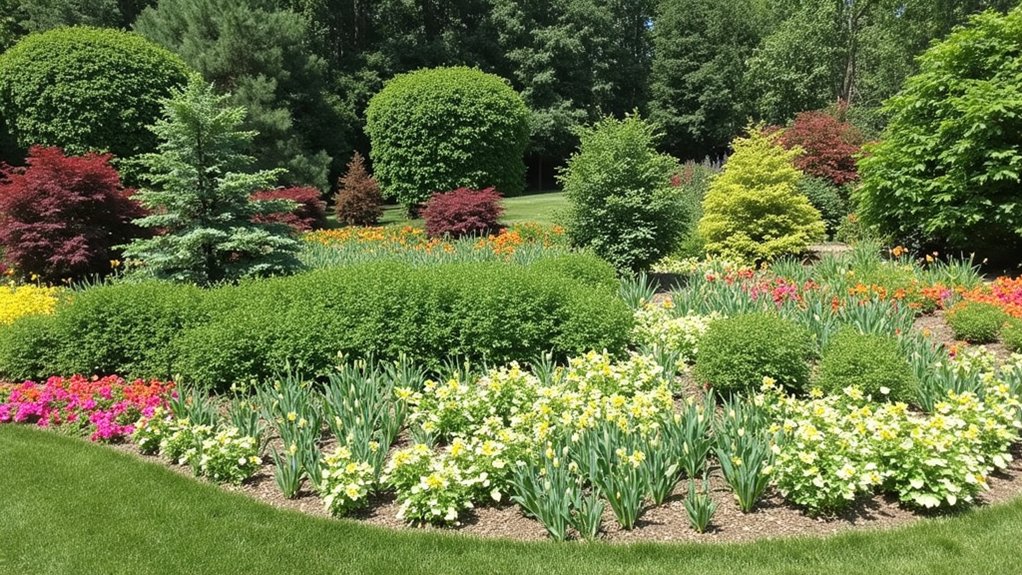
Hey, let’s plunge into seasonal color planning for your garden. You’ve gotta think ahead to keep it vibrant year-round. Start by mapping out a 12-month calendar, marking key bloom times for each season.
Choose plants with staggered flowering periods, like perennials that peak in summer, and shrubs for fall color. Research bloom durations, ensuring at least 2-3 weeks of overlap between cycles. This way, there’s no dull gap in your yard.
Next, sketch a layout on graph paper, using a 1-inch-to-5-feet scale for accuracy. Place taller plants, around 3-5 feet, at the back, and shorter ones, under 2 feet, upfront. Check local planting zones, too, for timing. Adjust your plan every 3 months, tweaking as you observe growth. Keep it stunning!
Spring Bulb Selection
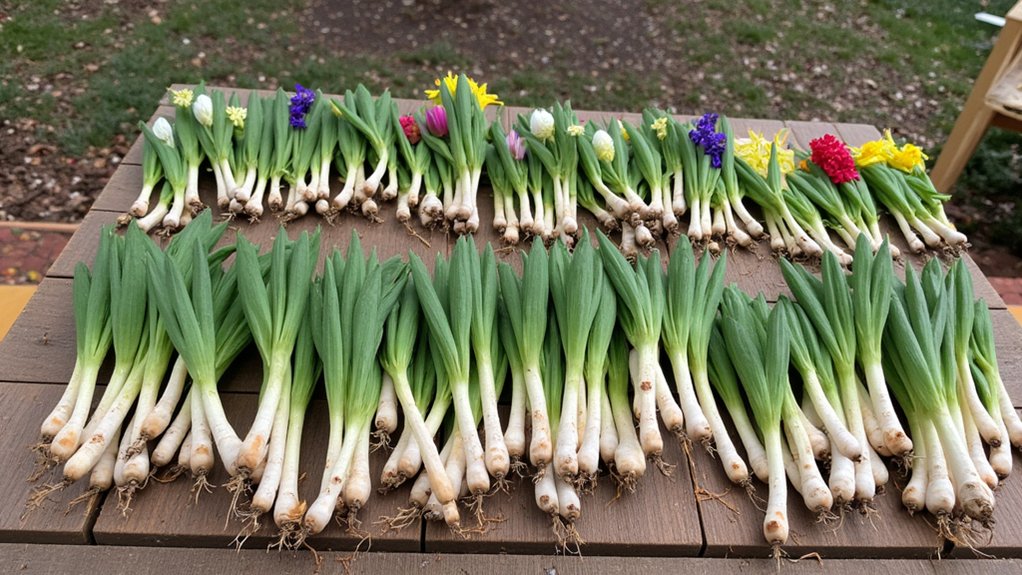
Let’s shift gears from planning your garden’s seasonal colors to picking the right spring bulbs for a stunning display. You’ve gotta start early, so plan to plant in fall, ideally late September to early November. Timing’s key here; it gives bulbs a chance to root before spring.
Choose classics like tulips, daffodils, or hyacinths for vibrant pops of color. Check bulb packages for bloom times—early, mid, or late spring—and mix them up for a longer show. Plant them 6-8 inches deep, pointy end up, in well-drained soil with full sun.
Don’t skimp on quantity; plant in clusters of 10-15 for impact. Space them 4-6 inches apart, water well after planting, and mulch lightly. You’ll see results when spring hits!
Winter Evergreen Structure
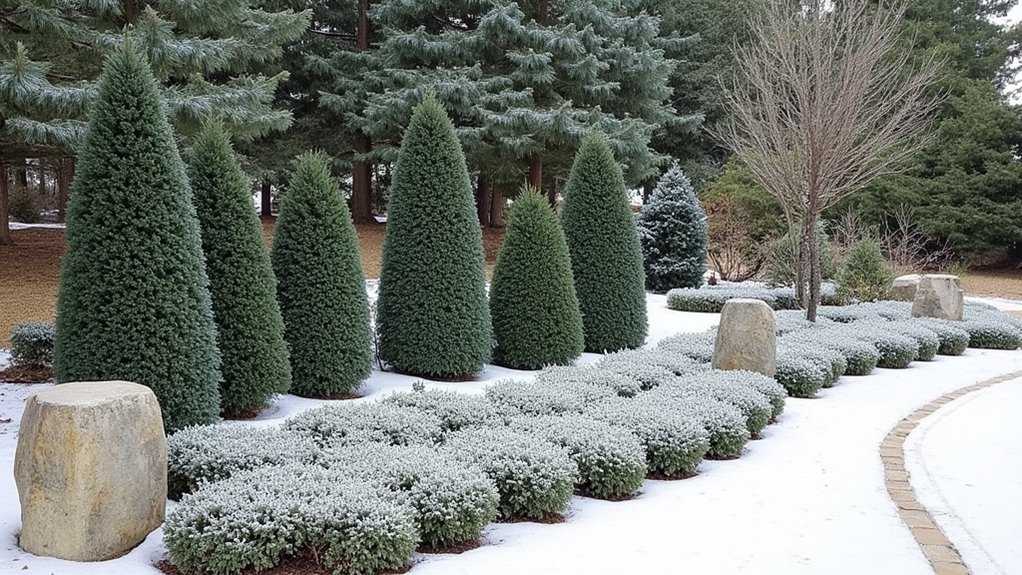
Now that spring bulbs are sorted, turn your attention to crafting a solid winter evergreen structure for your garden. Evergreens are your backbone when everything else fades, so let’s get this right. Start by picking hardy shrubs like boxwood or holly, which stay green all year.
Place them strategically near entryways or along pathways, about 3-5 feet apart, to create a defined look even in snow. Next, consider height—mix taller pines, around 6-10 feet, with shorter junipers for depth. Plant them in late fall, before the ground freezes, ensuring roots settle by winter.
Don’t skimp on spacing; overcrowding kills airflow. Check soil drainage too, as evergreens hate soggy roots. With this setup, your garden’s got winter grit.
Summer Flowering Perennials

How can you make your garden pop with color during the hot months? Well, summer flowering perennials are your go-to solution. These plants, like daylilies and coneflowers, bloom reliably from June to August, giving vibrant hues. Pick varieties suited to your zone for best results.
Start by preparing your soil in late spring, adding compost for nutrients. Plant perennials, spacing them 12-18 inches apart, in full sun areas—most need 6 hours of light daily. Water them deeply, about 1 inch per week, to establish roots. Deadhead spent blooms regularly to encourage more flowers.
Don’t skimp on mulch; lay down 2-3 inches to retain moisture and fight weeds. With these steps, you’ll enjoy a colorful, thriving summer garden!
Fall Foliage Highlights
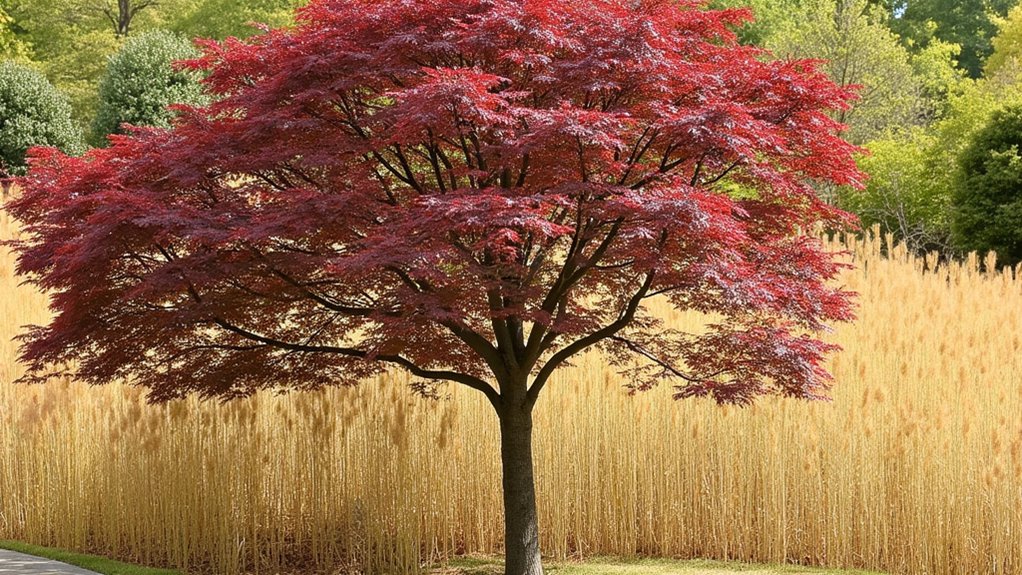
As summer fades, turn your attention to crafting a stunning fall garden with vibrant foliage. You’ve got to pick plants that pop with color, like maples or burning bushes. Their leaves turn fiery red and orange, usually by mid-October, creating a bold backdrop.
Start by mapping out your space—measure areas, say 5 by 10 feet, for key trees or shrubs. Plant Japanese maples for deep crimson tones; they thrive in partial shade and need well-drained soil. Check your zones, and aim to plant by early September for root establishment.
Don’t overlook smaller additions, like ornamental grasses. Their golden hues, peaking around late October, add texture. Mix heights and colors, and you’ll keep your garden lively through fall’s chill.
Autumn Container Arrangements
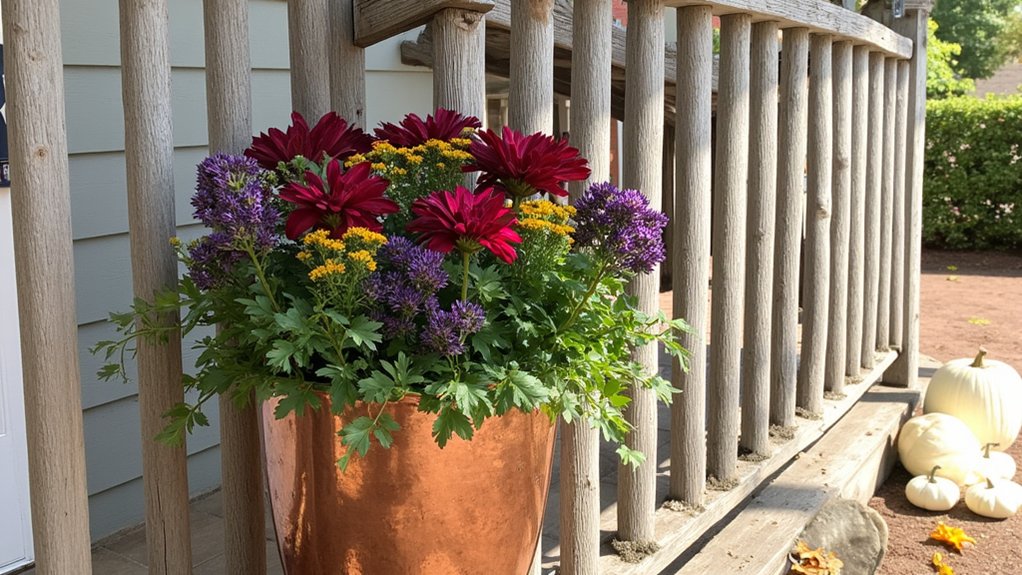
Let’s shift gears and talk about sprucing up your space with autumn container arrangements. You can transform patios or porches with vibrant, seasonal displays. Start by grabbing containers, ideally 12-18 inches deep, to hold hearty fall plants.
Choose plants like mums, ornamental kale, or pansies for bold color. Then, add texture with small pumpkins or dried corn stalks, tucking them around the edges. Make sure you place heavier items at the bottom for stability.
Next, fill your pots with well-draining soil, about 2 inches from the top, before planting. Water them every 3-4 days, keeping soil moist but not soggy. Position containers in spots with partial sun, checking weekly for wilting. With these steps, you’ll create stunning autumn vibes!
Year-Round Garden Lighting
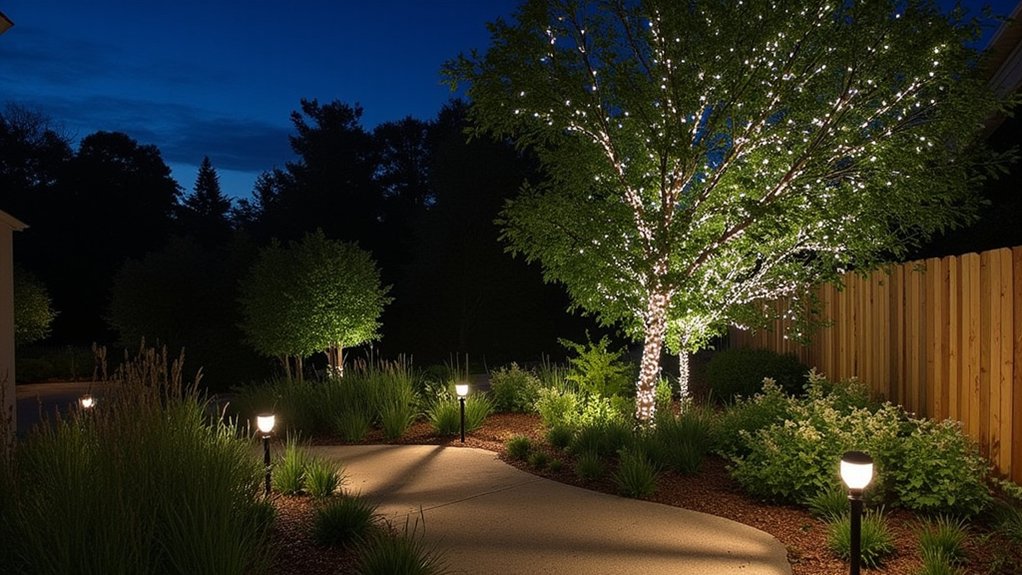
While autumn displays add seasonal charm, it’s time to brighten your garden with year-round lighting. Don’t let the dark months dim your space; instead, plan a setup that works every season. Lighting can highlight paths, plants, and features, so let’s get started.
First, install solar-powered stake lights along walkways, spacing them 3-5 feet apart for even glow. They’re easy to set up, just push them into the soil, and they charge by day. Next, add string lights in trees or along fences, securing them with zip ties every 2 feet to prevent sagging. For safety, use weatherproof extension cords if needed.
Finally, consider timers for convenience, setting them to turn on at dusk. Test everything after installation, adjusting as necessary for the best effect.
Seasonal Texture Variety
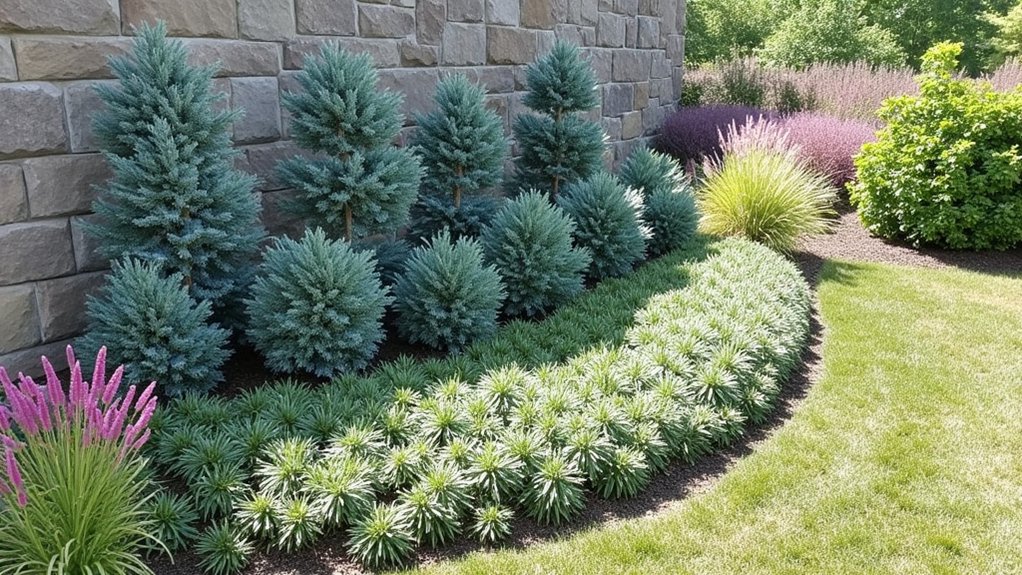
Now that your garden glows with lighting, turn your attention to adding seasonal texture variety for visual depth. You’ve got to mix things up with plants that change through the year. Think about rough, bumpy bark on trees like oaks in winter, contrasted with soft, feathery ferns in spring.
Start by planting evergreens, like a 3-foot-tall juniper, for a consistent coarse texture. Then, add summer bloomers, such as coneflowers, with their prickly centers popping by July. In fall, toss in ornamental grasses—maybe a 2-foot switchgrass—for that wispy, flowing look.
Check your garden monthly to spot gaps in texture. Replace or add plants as needed, ensuring there’s always something interesting, no matter the season. Keep it varied, and you’re set!
Seasonal Pathway Design
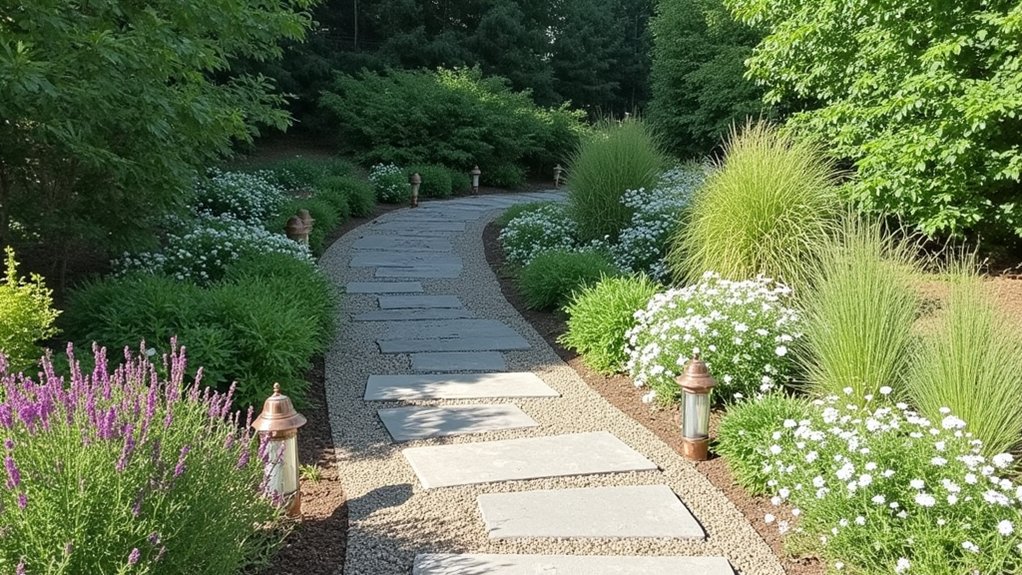
After mastering seasonal textures, turn your focus to crafting pathways that adapt through the year. You’ve gotta think about materials and layout that shift with the seasons, keeping your garden accessible and striking.
Start by choosing materials like gravel or stepping stones, about 3 feet wide, for easy walking. In spring, line paths with low-growing thyme; it’ll release a subtle scent when stepped on. Come fall, sweep away leaves weekly to avoid slippery spots, and consider adding small solar lights, spaced every 6 feet, for winter nights.
Don’t forget seasonal upkeep! Rake debris after storms, and in summer, check for uneven stones—fix ‘em quick to prevent trips. With these steps, your paths will shine year-round, guiding you effortlessly.
Seasonal Water Features
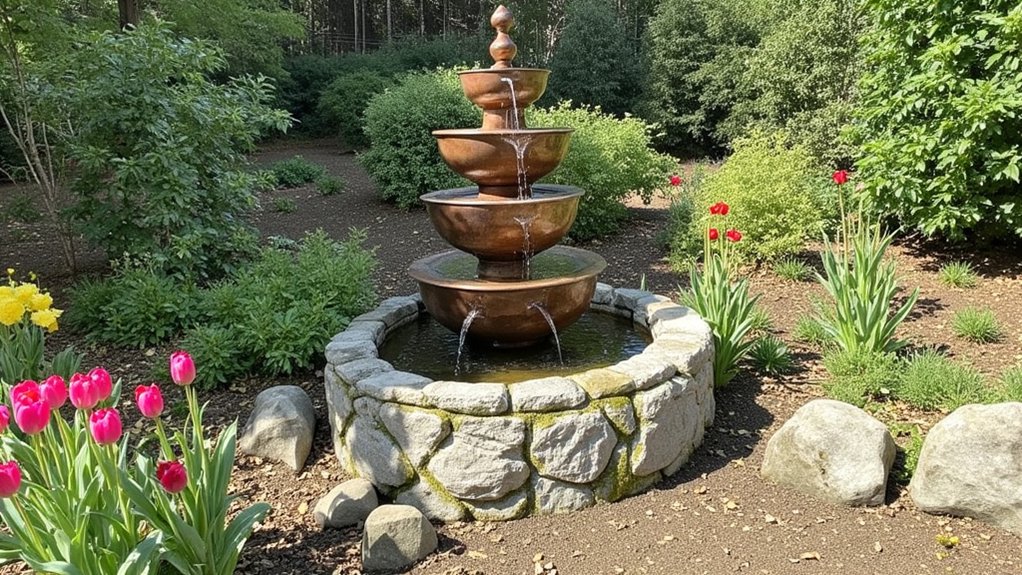
As you immerse yourself in enhancing your garden, let’s tackle the charm of seasonal water features. They’re a fantastic way to add life, especially when tailored to each season.
Start with a small fountain, about 2 feet tall, for spring’s gentle vibe. Place it near blooming flowers, and run it daily for 4-6 hours to keep water fresh. In summer, switch to a shallow birdbath, roughly 18 inches wide, to attract birds. Clean it weekly to avoid algae.
For fall, install a 3-foot-wide reflecting pool; it’ll mirror colorful leaves beautifully. Winter calls for a heated birdbath, set at 40°F, to provide water when it’s scarce. Check it daily, ensuring it’s ice-free, and you’ve got year-round appeal!
